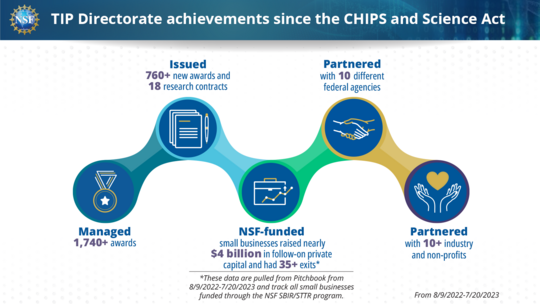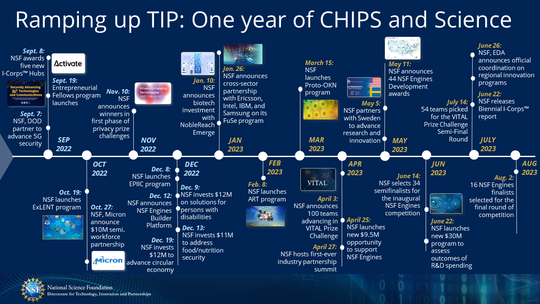One year ago, President Biden signed the CHIPS and Science Act into law, authorizing the establishment of the Directorate for Technology, Innovation and Partnerships (TIP). This directorate is NSF’s first in more than 30 years and builds upon the agency’s historic mission of serving as a beacon of U.S. innovation for nearly 75 years.
TIP is a strategic mindset that speeds the cycle of discovery and innovation and supercharges research outcomes. TIP allows research to more quickly become useful to people and the planet – accelerating breakthrough technologies that address our important national, societal, and geostrategic challenges – while also getting every American, regardless of background or location, involved and trained in these critical areas. TIP’s mission is critical to advancing U.S. competitiveness.
Under the leadership of NSF Director Sethuraman Panchanathan, NSF is meeting this mission by leveraging partnerships and cultivating innovation throughout the U.S. to advance use-inspired research, with a particular focus on breakthrough technologies and national, societal, and geostrategic challenges; enhance the translation of key technologies to the market and society; and provide new pathways for people of all backgrounds and perspectives to become part of the STEM-driven workforce.
In the year since the enactment of the CHIPS and Science Act, we have issued more than 700 new awards, managed more than 1,700 active awards, and partnered with 10 different federal agencies and more than 10 industry groups or nonprofits. We encourage you to learn more about what TIP and NSF have accomplished since last August on the NSF’s CHIPS and Science website. We also summarize below a few highlights.

Diverse innovation ecosystems
A key focus for TIP has been fostering innovation and technology ecosystems throughout the nation, with the explicit goal of creating opportunities for everyone everywhere. The NSF Regional Innovation Engines (NSF Engines) program, launched shortly after the establishment of the new directorate, was designed to drive research and development in key technology areas, nurture a diverse workforce, and foster economic development around important national, societal, and geostrategic challenges across the U.S., particularly in regions that have not benefited fully from recent technology booms. The response from the community has exceeded even our own expectations: TIP received nearly 700 concept outlines for NSF Engines awards spanning more than 500 organizations (including 40% that had not previously received funding from NSF) from every state and territory. In May of this year, we awarded 44 NSF Engines Development Awards spanning 46 U.S. states and territories, and just last week, we announced 16 NSF Engines Finalists for the awards we anticipate announcing by year’s end. Throughout this process, we have actively encouraged collaboration and teaming. Just last month, we also announced a partnership with the U.S. Economic Development Administration (EDA) to officially collaborate on regional innovation programs.
Technology translation and development
TIP has been building on NSF’s history of advancing translational research across the federal government. For example, NSF was the first agency to pilot the Small Business Innovation Research (SBIR) program in the 1970s and 1980s – an initiative that is now government-wide and was recently extended by Congress as part of the SBIR and STTR (Small Business Technology Transfer) Act of 2022. Beyond continuing to innovate in our existing Lab-to-Market portfolio — encompassing SBIR/STTR, as well as the NSF Innovation Corps (I-Corps™) and Partnerships for Innovation (PFI) programs – TIP launched new translational pathways to help researchers develop and prototype new technologies and solutions. In the fall, we awarded the first slate of Pathways to Enable Open-Source Ecosystems (POSE) awards, enabling researchers to harness the power of open-source development to find new technology solutions to national, societal, and geostrategic challenges. We also began working with the nonprofit Activate on NSF Entrepreneurial Fellowships, which provide scientists and engineers from diverse backgrounds and regions across the U.S. with the resources and training needed to translate research breakthroughs into new products and services. And we announced a pilot with NobleReach Emerge, formerly In-Q-Tel Emerge, to help guide NSF-funded researchers in developing and commercializing new biotechnologies and bio-inspired designs. In the coming months, the program will invest in building the infrastructure and capacity at universities to translate basic research outcomes into impactful solutions.
Workforce development
NSF has launched several efforts to strengthen workforce development and make STEM careers more attractive and accessible to individuals from all backgrounds throughout the U.S. To note a few early successes, TIP and several other NSF directorates partnered with Micron and Intel Corporation to support semiconductor design and manufacturing workforce development and also worked across NSF to launch the Experiential Learning for Emerging and Novel Technologies program to connect interested companies, governments and nonprofits with individuals looking for paid opportunities to explore STEM career paths, reskilling or develop new skills.
Laying out an investment roadmap
Finally, pursuant to the requirements of the CHIPS and Science Act, TIP has also been developing a roadmap to guide investment decisions in use-inspired and translational research over a three-year time frame, with a strategic focus on advancing U.S. competitiveness and developing the U.S. workforce in the 10 key technology areas and five national, societal, and geostrategic challenges specified in the legislation. In May, TIP issued a Request for Information (RFI) to gather insights from the public on staging TIP investments; and together with the NSF Directorate for STEM Education, a RFI on future topics for career pathways in key technology areas. Relatedly, building on the early success of a pilot National Network for Critical Technology Assessment funded in Fall 2022, TIP issued a new program solicitation, Accelerating and Predicting Technology Outcomes (APTO), to assess how investments in science and technology research and development will contribute to specific outcomes for the Nation. Collectively, these efforts serve to inform the investment roadmap, both in the short and longer terms.
These are just a few of the exciting new developments from TIP over the past year. As we mark the first anniversary of the CHIPS and Science Act, we take tremendous pride in the many new and innovative opportunities we have afforded to diverse participants all across the country. At the same time, we recognize we have work to do to successfully build on this foundation in the years ahead.
To that end, let us leave you with one call to action: the success of the CHIPS and Science Act is dependent not on Congress, not on NSF, but on all of us working together. We challenge you all to dream big and bold for the future of your region and the nation – and to be sure to take advantage of the full breadth of interconnected programs that TIP is beginning to offer. By working together, we can, as the Director says, create opportunities for everyone, everywhere, and ensure the U.S. remains in the vanguard of competitiveness for decades to come.
With gratitude,
Erwin Gianchandani
NSF Assistant Director for Technology, Innovation and Partnerships
Gracie Narcho
NSF Deputy Assistant Director for Technology, Innovation and Partnerships
- SEO Powered Content & PR Distribution. Get Amplified Today.
- PlatoData.Network Vertical Generative Ai. Empower Yourself. Access Here.
- PlatoAiStream. Web3 Intelligence. Knowledge Amplified. Access Here.
- PlatoESG. Automotive / EVs, Carbon, CleanTech, Energy, Environment, Solar, Waste Management. Access Here.
- BlockOffsets. Modernizing Environmental Offset Ownership. Access Here.
- Source: https://feeds.feedblitz.com/~/772462424/0/cccblog~TIP-Quarterly-Update-One-year-anniversary-of-the-CHIPS-and-Science-Act-getting-signed-into-law/




